FC Groningen has been home to many footballing stars over the years, including Arjen Robben, Ronald Koeman, and Luis Suarez. But most recently, the Dutch club nurtured Liverpool centre-back Virgil van Dijk, before his move to Celtic. He has since become the best defender in world football. With the cancellation of the Eredivisie, Groningen found themselves with the third-best defence in the league, conceding only three more goals than Ajax. Instrumental to this feat was 22-year-old right-back, Deyovaisio Zeefuik.
This tactical analysis will focus on the young defender. He racked up 26 games this season in the league, showing his importance to his team’s solidity. Zeefuik graduated from the famous Ajax academy, breaking into the first team during the 2017/18 season, making 18 appearances. Since his move to Groningen, he has been able to establish himself as a starter.
His strong season has led to reported interest from Southampton and PSV, so let’s analyse why.
Strong defending
Zeefuik’s rolled down socks and huge build makes him impossible to miss on a football pitch. The young Dutchman’s power and strength are key to stopping his opposition. He has just under the league average for defensive duels per 90, with 7.75. However, his success rate is the best in the league amongst other full-backs (70.6%).
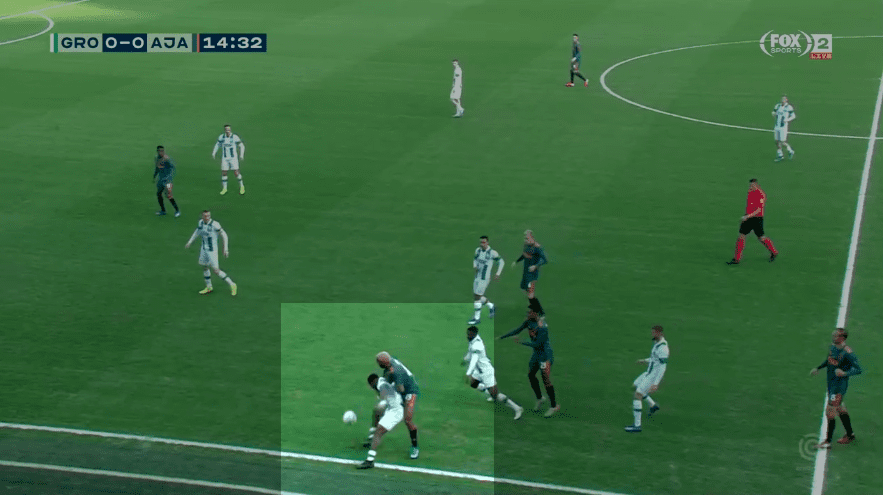
His huge build means that once he gets his body in-between man and ball, he is extremely difficult to get around, as we can see in the above example with Ryan Babel. This, along with his tremendous pace means that his defending in one-on-one situations is very effective. However, he can underestimate his power, often giving away fouls, 1.27 per game this season.
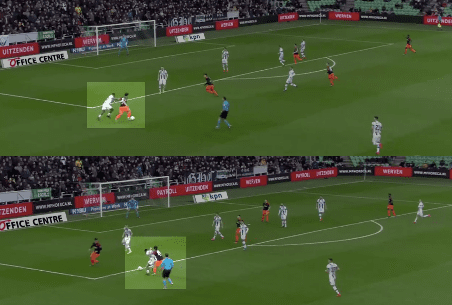
Against PSV, he appears to get beaten – as we can see in the first image. However, he is able to use his strength and pace to push his opponent off the ball. He then shows a level of composure to lay the ball back to his teammate to clear.
This scout report will prove that the Groningen right-back isn’t just a brute defender that bullies the opposition. The youngster can read the game very well, sniffing out moments of danger that could arise.
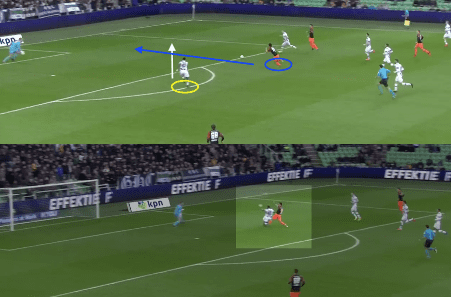
Here, Zeefuik prevents his team from conceding. PSV have disorganised Groningen’s defensive line, meaning there are gaps to pass into. Zeefuik identifies this. Although risky, he leaves his man and uses his pace to cover. He is then able to slide tackle his opponent, taking the ball cleanly. His covering and last-ditch challenges have been a great aspect this season, completing 76.2% of his slide tackles.
We see a similar example below against Vitesse. Zeefuik again leaves his man to cover the player in on goal.
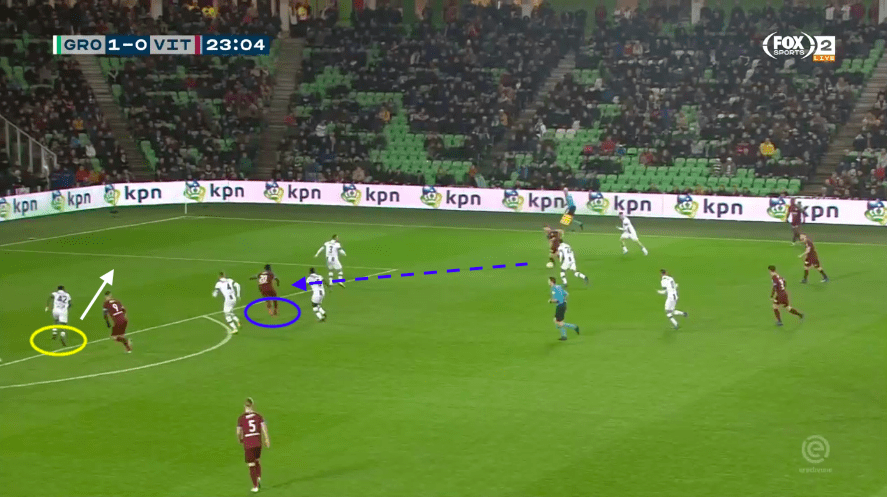
His ability to sense danger when none of his teammates can make him irreplaceable. His pace allows him to reach the attempted pass before the attacker, clearing it to safety. However, this type of aggressive defending means that Zeefuik has to choose the correct situations in which to leave his man, making it very risky.
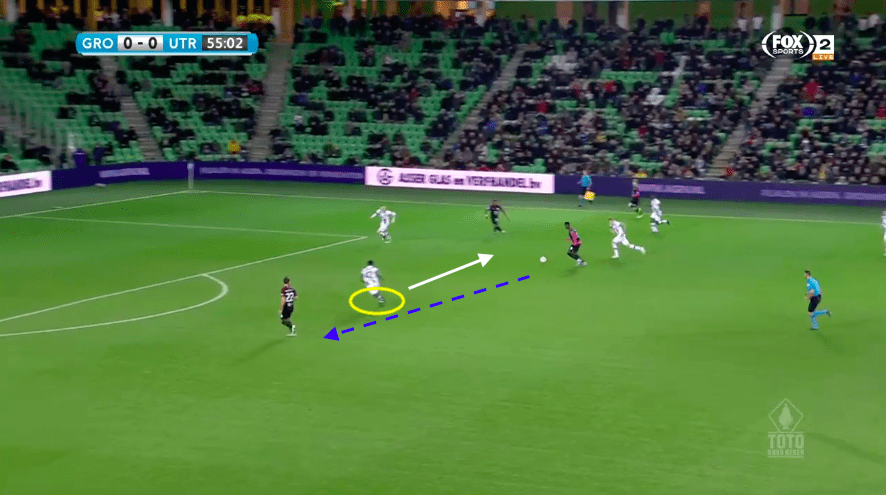
During a dangerous Utrecht counter-attack, Zeefuik is put in a decision making situation. In this scenario, he makes the wrong choice. As he has a teammate closing the attacker down, and another covering, the correct decision would be to mark the man behind him. As Zeefuik moves towards the man with the ball, the highlighted pass is made, leaving him open. Fortunately, nothing comes of this attack. But this scenario highlights that the young defender must be more careful with his aggressive defence.
How does the young right-back compare to Aaron Wan-Bissaka of Manchester United, who is regarded as one of the best defensive full-backs?
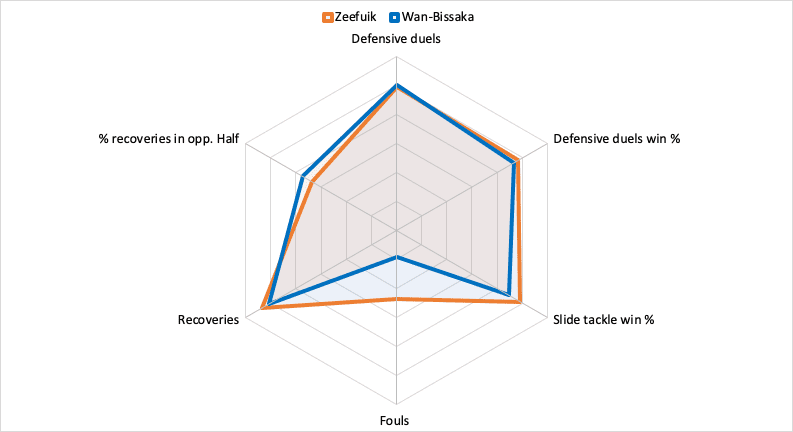
This graph shows that Zeefuik is superior when it comes to defending, although we must consider the standard of the league they both play in. Both face a similar amount of defensive duels per 90, with the Dutch right-back winning more, but also committing more fouls.
Commitment to the cause
As mentioned previously, Zeefuik is an incredibly aggressive and passionate player. This means that he is very committed, which, depending on the situation, can be a bad thing.
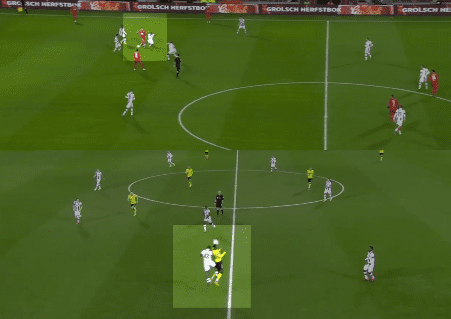
The former Netherlands U21 international has a bad habit of diving into challenges when there’s a good chance it will hurt his opponent. In the first image above we see him diving into a tackle from the wrong side. The second example shows him putting his shoulder into the attackers back, following an aerial duel that he was unlikely to win. His lack of discipline has earned him three yellow cards and one red card this term. An improvement however from last season, where he picked up 10 yellow cards.

One of his worst games this season came against ADO Den Haag, which saw him commit numerous fouls. Just before half time Zeefuik committed a foul, and kicked the ball away in disagreement, earning him a yellow card. The following free-kick resulted in the opposition equalising. In the next play, straight from kick-off, the angry right-back went up for an aerial duel, leading with his elbow. After a VAR check, Zeefuik was shown a straight red card. This example shows that the defender needs to learn to control his temper if he is to progress his career.
With all the negatives that come with an aggressive nature, there are some positives. Zeefuik’s running is an important part of his game, whether this is in attack or defence.
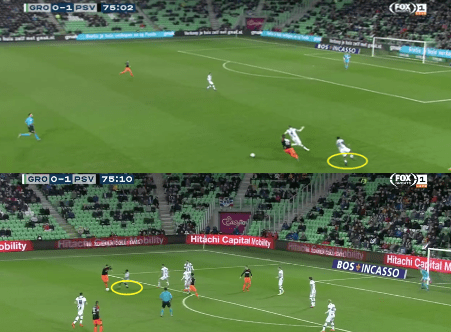
In defensive terms, Zeefuik’s determination means he will not give up until his team has cleared the ball safely. Following a PSV counter-attack, the right-back runs from inside the opposition box to his position in the first image to resume his defensive responsibilities. Then, just eight seconds later, he is on the other side of the field preventing the attacker from having a shot at goal. A real powerhouse effort. His hard work shows in his 10.1 recoveries per 90, completing 25.8% of these in the opposition half.
His hard work doesn’t end in defence, however. Although Zeefuik’s priority is defending, he does like to get forward and support his teammates. The former Ajax man isn’t considered a modern fullback, meaning his defending is superior to his attacking. He prefers to advance up the field without the ball, rather than with.
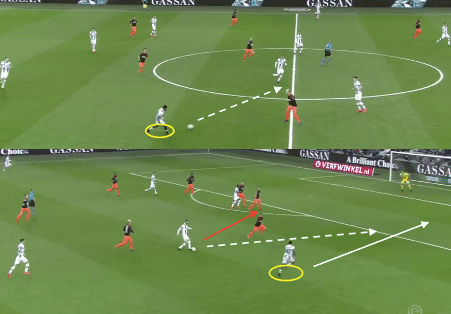
Here, we see him give the ball to his teammate, before continuing his run down the right flank. This allows him to ghost into space because he doesn’t have the ball. In the second image, we see him offering himself as an option. The player in possession can either make a through ball to Zeefuik or use his run as a dummy to open up space for himself.
Zeefuik has only registered two assists this season, but this may be due to the team he is playing in, as Groningen have struggled to score this season.
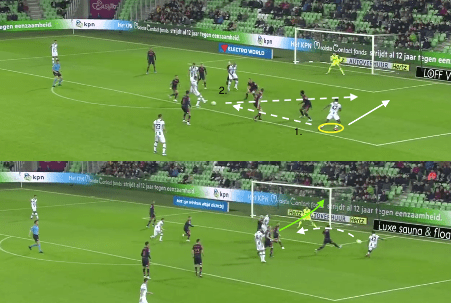
The above example shows his assist against RKC Waalwijk. He plays an intricate one-two with his teammate, using his pace to beat his defender. After Zeefuik receives the ball, he chips a pass into his striker who pokes the ball home.
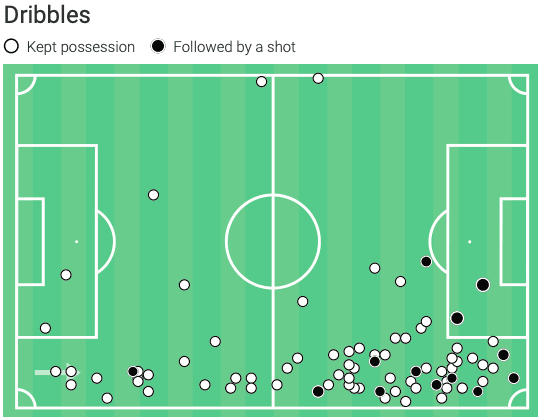
In the above map, we can see where the Dutchman is most likely to dribble the ball, rather than pass. He prefers to pass the ball out of defence and runs at opposition players in their half. As the map shows, many of his dribbles were followed by a shot, rather than a pass, and this is one of his weaknesses.
Zeefuik is incredibly hard to stop whilst running with the ball because of his power and pace, completing 63.5% of his dribbles. However, his decision making and end product are often unable to back up his dribbling skills. His inability to look up whilst running at pace means he often doesn’t find a pass, as evident in the example below.
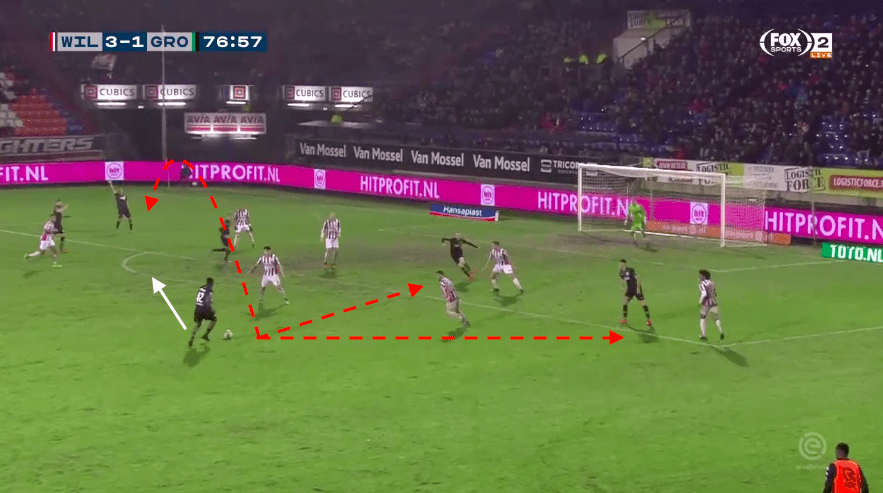
There are three teammates that he could find. Instead, he decides to take the ball onto his weaker left side and hit a shot that drags along the floor. Once again questioning his end product.
Contributing in attack
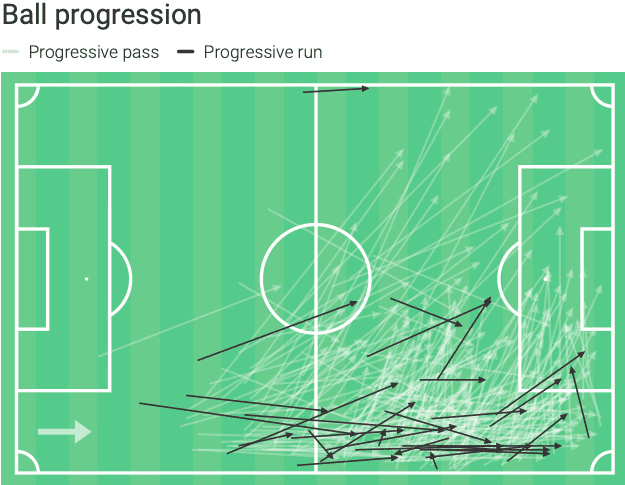
As the map shows, most of Zeefuik’s progressive runs are in the opposition half, also evident in the fact that only 34.3% of his ball losses are in his own half. He averages 2.28 progressive runs per 90.
The right-back likes to use his range of passing to advance his team up the pitch and subsequently create chances. As the map above shows, he likes to switch play when his teammates are in space with long diagonal balls. As evident in the example below.
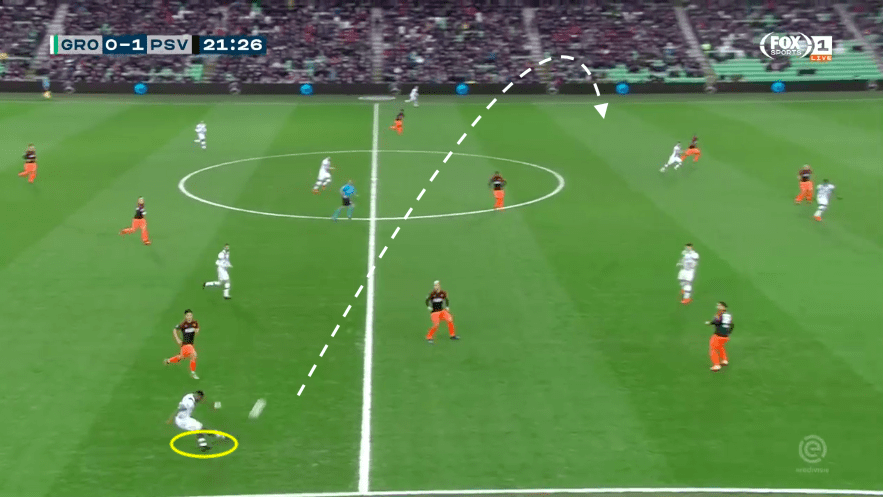
Although maybe not the best option here, Zeefuik produces a long diagonal pass to his opposite full-back. With the Groningen striker dragging his marker inside, this opens up space for the left-back to run into. His intelligent defending we mentioned earlier is matched with his ability to make incisive passes in attacking areas.
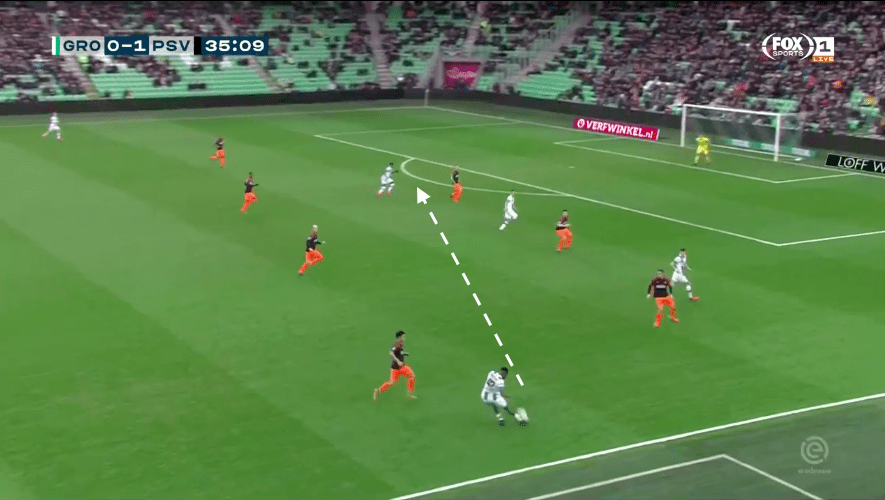
Zeefuik finds himself on the right flank with limited options, this means he needs to produce a clever pass. He gets his head up and spots that his teammate isn’t being tightly marked. He produces an excellent pass, in between the defensive and midfield lines.
His second assist came against Sparta Rotterdam, with a similar type of pass.
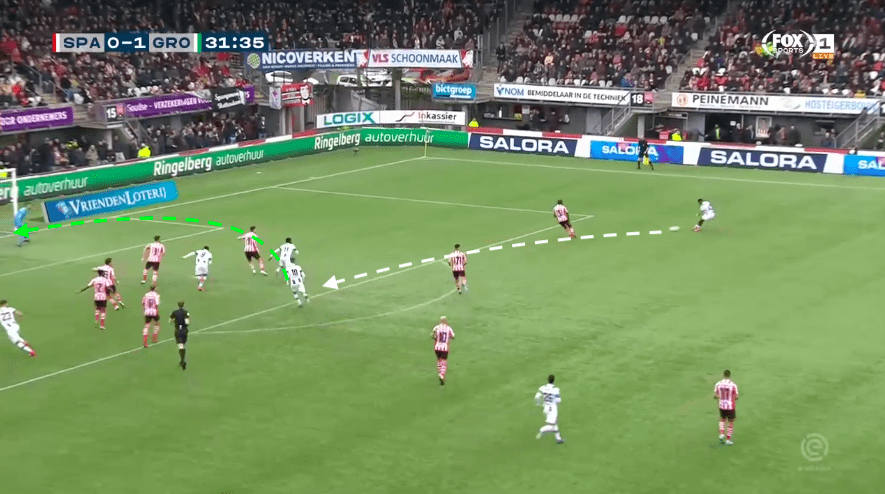
He finds himself in space on the right and gets his head up to find a pass into the box. He spots his teammate, Roman Lundqvist in space at the edge of the box. He makes a powerful low pass into his teammate’s path meaning he’s able to strike the ball first-time. He has 2.9 passes to penalty box per 90 and 2.79 crosses per 90.
But how does he compare with the best? Let’s see how the Groningen defender compares with Trent Alexander-Arnold.
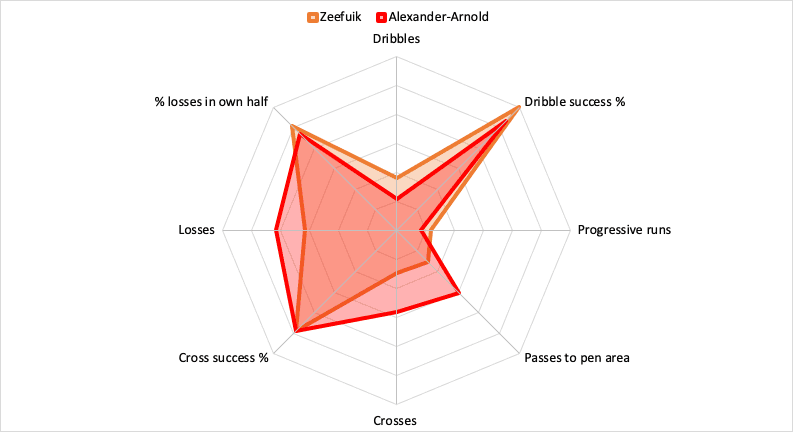
From analysing the stats we can instantly see that Alexander-Arnold takes more risks because he plays in a significantly better team. The Liverpool right-back has more passes to the penalty area, crosses and more losses. However, Zeefuik has more progressive runs, dribbles and dribble success %.
Conclusion
This tactical analysis has shown that Deyovaisio Zeefuik could become an incredibly good defender if he wipes out the silly mistakes in his game. Though he hasn’t been tested in tougher leagues, he performs well against the better teams in the Eredivisie. His strength and dynamic style of play would be perfect for any mid-table Premier League team, suiting many of their tactics.
In his second full season in professional football, he has certainly impressed many, with his team surprisingly boasting the third-best defence in the league this season. The 22-year-old needs to make sure he becomes more sensible with his type of tackles, as more skilful players will beat him easily. He has certainly shown signs over the past season that he would be more than capable of defending and attacking in a more competitive league.





Comments